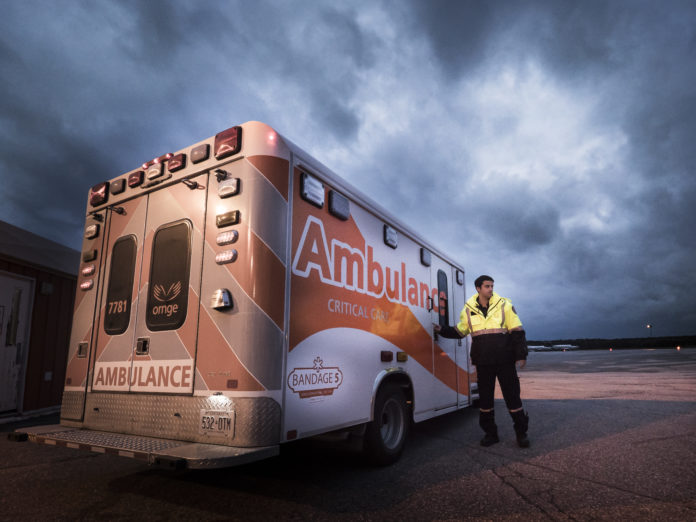By James McDonald
If the sights and sounds of an Ornge air or land ambulance were familiar in the Greater Toronto Area before COVID-19, in April 2021, these could be described as omnipresent. As GTA ICUs reach and exceed their capacity as a result of a surge in COVID-19 cases, patient transport has become a critical lifeline for hospitals.
Even for a medical transport organization like Ornge, Ontario’s provider of air ambulance and critical care transport services, the events of the past month have been extraordinarily challenging.
“There is nothing that we can compare it to. It is the busiest we’ve ever been,” says Justin Smith, Chief Flight Paramedic at Ornge.
“It is an incredibly complex piece to move a patient who requires critical care,” says Dr. Michael Lewell, Associate Medical Officer for Ornge. “Our teams are accustomed to transporting patients with mechanical ventilators and multiple infusions, and do this with such skill and precision every day.”
In Ontario’s third wave of the pandemic, ICUs in the GTA are experiencing a volume of patients that is more than double the load during the second wave. This has resulted in the need for ‘load sharing’ – where hospitals under significant capacity pressure can transfer patients to other facilities with ICU beds available.
This approach has accelerated in recent weeks, as COVID patients in GTA hospitals were transferred to destinations such as London or Kingston, or even several hundred kilometres away to Sudbury, Ottawa, Windsor or North Bay. In some cases, smaller hospitals which would ordinarily send patients to larger facilities for a higher level of care are now themselves receiving patients.
The Ontario Critical Care COVID Command Centre, which was established during the initial response to the pandemic in April 2020, carefully monitors hospital capacity data throughout Ontario. With multiple partners at the table including Ornge, CritiCall, regional Ontario Health critical care leaders, and Critical Care Services Ontario (CCSO), daily transport requirements are determined and centrally coordinated to preserve hospital capacity.
Once a patient has been identified who requires transport from a hospital under pressure, patient information and other logistics are sent to CritiCall, then pushed to the Ornge Emergency Operations Centre (EOC) where specialized Communications Officers and Ornge Transport Medicine Physicians (TMP) review every patient to assign the appropriate level of care required, and ensure patient safety.
“These people in the background put all those pieces together to get to the right patient to the right hospital in the right amount of time,” says Michael McCallion, Operations Control Manager for Ornge. “There is a deluge of calls between 10 a.m. and four o’clock in the afternoon when we’re taking call after call after call. You’re on for 12 hours of the day planning and conversing and making entries. At the end of the day, they’re pretty tired.”
When the EOC was first activated, approximately 200 patient transports per month were coordinated through the centre. In April, more than 700 patient transports had been processed in the first three weeks of the month alone.
Patients identified for transport may fall into one of two categories: ICU patients requiring complex medical care including ventilation, and “acute” patients who are hospital ward based requiring lower volumes of oxygen but are at risk for deterioration and may eventually require ICU care.
ICU patients are transported using Ornge Critical Care Land Ambulances (CCLA) based in the GTA and southern Ontario, as well as Ornge helicopters and airplanes for medium and longer distance transports. In some instances, hospital based teams have been created in centres such as Kingston, Barrie, London, Sudbury, Ottawa and completed ICU transports in partnership with land based municipal Paramedic Services.
Acute patients, given their relative stability, are typically transported by municipal Paramedic Service partners throughout southern Ontario.
As more patients are admitted to the ICU each day, the demand for patient transports is increasing. To meet this demand, with support from the Ministry of Health, Ornge has tripled its GTA land transport capacity by making new resources available, including extra Critical Care Land Ambulances based in Mississauga. These are staffed by members of the organization’s Surge Response Team, comprised of Ornge paramedics who have volunteered for overtime. York Paramedic Service loaned multi-patient ambulance buses which are capable of transporting two patients at a time. This vehicle can be particularly helpful when moving patients who are being transferred from the same hospital to the same location.
“I’m fiercely proud of the work that our team does. Nevertheless, I don’t think we can underscore enough the sobering reality of what we’re confronted with on a daily basis,” says Dr. Lewell. “It’s a story of collaboration and all hands on deck, but it’s certainly a very sobering moment.”
James MacDonald is the Director of Communications and Public Affairs for Ornge




